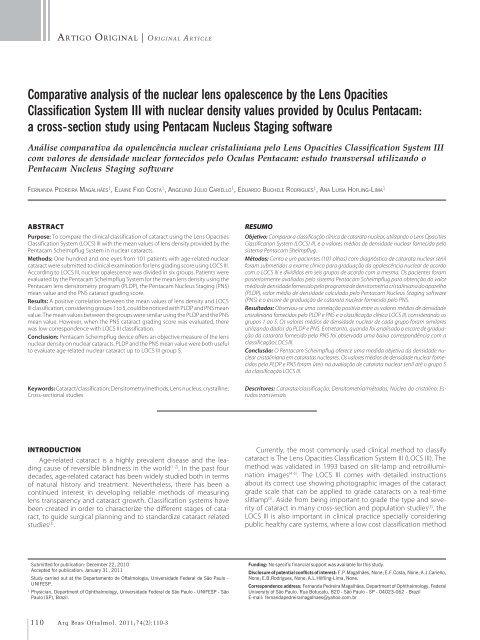a rquivos b rasileiros - Conselho Brasileiro de Oftalmologia
a rquivos b rasileiros - Conselho Brasileiro de Oftalmologia
a rquivos b rasileiros - Conselho Brasileiro de Oftalmologia
Create successful ePaper yourself
Turn your PDF publications into a flip-book with our unique Google optimized e-Paper software.
ARTIGO ORIGINAL | ORIGINAL ARTICLE<br />
Comparative analysis of the nuclear lens opalescence by the Lens Opacities<br />
Classification System III with nuclear <strong>de</strong>nsity values provi<strong>de</strong>d by Oculus Pentacam:<br />
a cross-section study using Pentacam Nucleus Staging software<br />
Análise comparativa da opalencência nuclear cristaliniana pelo Lens Opacities Classification System III<br />
com valores <strong>de</strong> <strong>de</strong>nsida<strong>de</strong> nuclear fornecidos pelo Oculus Pentacam: estudo transversal utilizando o<br />
Pentacam Nucleus Staging software<br />
FERNANDA PEDREIRA MAGALHÃES 1 , ELAINE FIOD COSTA 1 , ANGELINO JÚLIO CARIELLO 1 , EDUARDO BUCHELE RODRIGUES 1 , ANA LUISA HOFLING-LIMA 1<br />
ABSTRACT<br />
Purpose: To compare the clinical classification of cataract using the Lens Opacities<br />
Classification System (LOCS) III with the mean values of lens <strong>de</strong>nsity provi<strong>de</strong>d by the<br />
Pentacam Scheimpflug System in nuclear cataracts.<br />
Methods: One hundred and one eyes from 101 patients with age-related nuclear<br />
cataract were submitted to clinical examination for lens grading score using LOCS III.<br />
According to LOCS III, nuclear opalescence was divi<strong>de</strong>d in six groups. Patients were<br />
evaluated by the Pentacam Scheimpflug System for the mean lens <strong>de</strong>nsity using the<br />
Pentacam lens <strong>de</strong>nsitometry program (PLDP), the Pentacam Nucleus Staging (PNS)<br />
mean value and the PNS cataract grading score.<br />
Results: A positive correlation between the mean values of lens <strong>de</strong>nsity and LOCS<br />
III classification, consi<strong>de</strong>ring groups 1 to 5, could be noticed with PLDP and PNS mean<br />
value. The mean values between the groups were similar using the PLDP and the PNS<br />
mean value. However, when the PNS cataract grading score was evaluated, there<br />
was low correspon<strong>de</strong>nce with LOCS III classification.<br />
Conclusion: Pentacam Scheimpflug <strong>de</strong>vice offers an objective measure of the lens<br />
nuclear <strong>de</strong>nsity on nuclear cataracts. PLDP and the PNS mean value were both useful<br />
to evaluate age-related nuclear cataract up to LOCS III group 5.<br />
Keywords: Cataract/classification; Densitometry/methods; Lens nucleus, crystalline;<br />
Cross-sectional studies<br />
RESUMO<br />
Objetivo: Comparar a classificação clínica <strong>de</strong> catarata nuclear, utilizando o Lens Opacities<br />
Classification System (LOCS) III, e o valores médios <strong>de</strong> <strong>de</strong>nsida<strong>de</strong> nuclear fornecido pelo<br />
sistema Pentacam Sheimpflug.<br />
Métodos: Cento e um pacientes (101 olhos) com diagnóstico <strong>de</strong> catarata nuclear senil<br />
foram submetidos a exame clínico para graduação da opalescência nuclear <strong>de</strong> acordo<br />
com o LOCS III e divididos em seis grupos <strong>de</strong> acordo com a mesma. Os pacientes foram<br />
posteriormente avaliados pelo sistema Pentacam Scheimpflug para obtenção do valor<br />
médio <strong>de</strong> <strong>de</strong>nsida<strong>de</strong> fornecido pelo programa <strong>de</strong> <strong>de</strong>nsitometria cristaliniana do aparelho<br />
(PLDP), valor médio <strong>de</strong> <strong>de</strong>nsida<strong>de</strong> calculado pelo Pentacam Nucleus Staging software<br />
(PNS) e o escore <strong>de</strong> graduação <strong>de</strong> catarata nuclear fornecido pelo PNS.<br />
Resultados: Observou-se uma correlação positiva entre os valores médios <strong>de</strong> <strong>de</strong>nsida<strong>de</strong><br />
cristaliniana fornecidos pelo PLDP e PNS e a classificação clínica LOCS III, consi<strong>de</strong>rando os<br />
grupos 1 ao 5. Os valores médios <strong>de</strong> <strong>de</strong>nsida<strong>de</strong> nuclear <strong>de</strong> cada grupo foram similares<br />
utilizando dados do PLDP e PNS. Entretanto, quando foi analisado o escore <strong>de</strong> graduação<br />
da catarata fornecido pelo PNS foi observada uma baixa correspondência com a<br />
classificação LOCS III.<br />
Conclusão: O Pentacam Scheimpflug oferece uma medida objetiva da <strong>de</strong>nsida<strong>de</strong> nuclear<br />
cristaliniana em cataratas nucleares. Os valores médios <strong>de</strong> <strong>de</strong>nsida<strong>de</strong> nuclear fornecidos<br />
pelo PLDP e PNS foram úteis na avaliação <strong>de</strong> catarata nuclear senil até o grupo 5<br />
da classificação LOCS III.<br />
Descritores: Catarata/classificação; Densitometria/métodos; Núcleo do cristalino; Estudos<br />
transversais<br />
INTRODUCTION<br />
Age-related cataract is a highly prevalent disease and the leading<br />
cause of reversible blindness in the world (1-2) . In the past four<br />
<strong>de</strong>ca<strong>de</strong>s, age-related cataract has been wi<strong>de</strong>ly studied both in terms<br />
of natural history and treatment. Nevertheless, there has been a<br />
continued interest in <strong>de</strong>veloping reliable methods of measuring<br />
lens transparency and cataract growth. Classification systems have<br />
been created in or<strong>de</strong>r to characterize the different stages of cataract,<br />
to gui<strong>de</strong> surgical planning and to standardize cataract related<br />
studies (3) .<br />
Currently, the most commonly used clinical method to classify<br />
cataract is The Lens Opacities Classification System III (LOCS III). The<br />
method was validated in 1993 based on slit-lamp and retroillumination<br />
images (4-5) . The LOCS III comes with <strong>de</strong>tailed instructions<br />
about its correct use showing photographic images of the cataract<br />
gra<strong>de</strong> scale that can be applied to gra<strong>de</strong> cataracts on a real-time<br />
slitlamp (5) . Asi<strong>de</strong> from being important to gra<strong>de</strong> the type and severity<br />
of cataract in many cross-section and population studies (3) , the<br />
LOCS III is also important in clinical practice specially consi<strong>de</strong>ring<br />
public healthy care systems, where a low cost classification method<br />
Submitted for publication: December 22, 2010<br />
Accepted for publication: January 31, 2011<br />
Study carried out at the Departamento <strong>de</strong> <strong>Oftalmologia</strong>, Universida<strong>de</strong> Fe<strong>de</strong>ral <strong>de</strong> São Paulo -<br />
UNIFESP.<br />
1<br />
Physician, Department of Ophthalmology, Universida<strong>de</strong> Fe<strong>de</strong>ral <strong>de</strong> São Paulo - UNIFESP - São<br />
Paulo (SP), Brazil.<br />
Funding: No specific financial support was available for this study.<br />
Disclosure of potential conflicts of interest: F.P.Magalhães, None; E.F.Costa, None; A.J.Cariello,<br />
None; E.B.Rodrigues, None; A.L.Höfling-Lima, None.<br />
Correspon<strong>de</strong>nce address: Fernanda Pedreira Magalhães. Department of Ophthalmology, Fe<strong>de</strong>ral<br />
University of São Paulo. Rua Botucatu, 820 - São Paulo - SP - 04023-062 - Brazil<br />
E-mail: fernandapedreiramagalhaes@yahoo.com.br<br />
110 Arq Bras Oftalmol. 2011;74(2):110-3

















